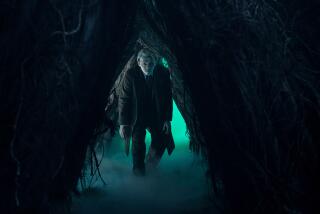TV REVIEWS : A Look Into Peter Sellars’ Skewed ‘Cabinet’ : He plays puckish host tonight for his update of ‘The Cabinet of Dr. Caligari’ on PBS.
- Share via
Peter Sellars is such a wag. Back in 1990, he scheduled the premiere of his two-hour silent movie “The Cabinet of Dr. Ramirez” for Hollywood Bowl during the Los Angeles Festival--though it hadn’t yet been shot.
Bearing a 1991 copyright, along with writer-director credits for Sellars, “Ramirez” turns up tonight on the PBS “Great Performances” series (8 p.m. on Channel 24, 9 p.m. on Channel 28). However, Sellars added only recently a whimsical prologue that initially seems a kind of infomercial but in fact radically alters the film’s meaning.
In the guise of host, Sellars addresses the viewer directly during this three-minute opening sequence, speaking deadpan about an inch from the camera. “This movie is goodby to the ‘80s and a film for the ‘90s,” he begins. “. . . We’re very, very privileged in this film that you’re about to see to have a great series of artists who offer something very profound.”
Strangely, much of what Sellars says about the film reflects the viewpoint of characters who wind up in straitjackets: terminally alienated yuppies played by Peter Gallagher and Joan Cusack who wander through an increasingly deserted Manhattan menaced by disoriented street people, among them Mikhail Baryshnikov.
“This is a movie about most of your life, when you’re not saying anything,” Sellars says, but what we see are Gallagher and Cusack making ESP phone calls (no talking), sleeping with the homeless, being murdered and then reappearing or waiting while maintenance crews sponge and scrub away pools of blood from around the office video display terminals. Over the top? Just wait.
To heighten the unreality, “Ramirez” uses John Adams’ brooding “Die Harmonielehre” as accompaniment, though when the action grows especially melodramatic, it resorts to the ritual chants of Tibetan monks seeking salvation--Sellars’ irony at its most puckish.
Dramatizing what he calls “the end of the Wall Street superstructure,” he spices his film with Downfall-of-Capitalism episodes and put-downs of police power as well. But most of it focuses on Gallagher clenching his eyebrows and Cusack pursing her lips as they cope wordlessly with alarming and mysterious events, hour after hour.
However, those events turn out to be hallucinations. Because Sellars appropriates the switcheroo ending of the 1919 German Expressionist classic “The Cabinet of Dr. Caligari,” all the views of recessionary ‘90s emptiness are insane fantasies--and, for all we know, Eisenhower is still President. The only question is exactly who’s hallucinating?
Cusack? Gallagher? Perhaps, but the new prologue mandates a new candidate, since everyone who remembers “Caligari” will know it’s the narrator who’s deranged. By casting himself in that role, Sellars shows ‘90s artists no less than yuppies as crazed implements of a decaying power structure. The restless hands are a dead giveaway: signals of a diseased compulsion to manipulate.
In the past, Sellars has acted in projects as varied as Jean-Luc Godard’s “King Lear” and “The Equalizer” TV series. Here, however, playing a character named Peter Sellars who mouths self-serving platitudes that draw the viewer into his skewed reality, he has found the role of a lifetime.
More to Read
The complete guide to home viewing
Get Screen Gab for everything about the TV shows and streaming movies everyone’s talking about.
You may occasionally receive promotional content from the Los Angeles Times.




